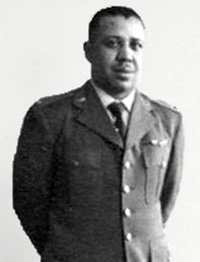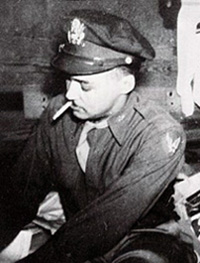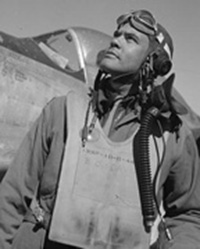
James Warren, Tuskegee Airman
Source: James Warren
When a unit of the 332nd Fighter Group, the 477th, found out that it was being transferred to Freeman Field in Indiana, the officers decided to challenge the segregated facilities at their new base immediately. The officers met even before they left for Freeman. James Warren, one of the officers involved, would later recall that an initial meeting was held to the protest, beginning immediately upon the unit's arrival at Freeman Field. While some members of the unit proposed more radical plans of action, the group of officers ultimately agreed that their efforts would be non-violent and based on action by small groups. Warren recalled that the group had agreed to display strict discipline. According to Warren, the men had discussed what to do if they were arrested, and they agreed that they would not commit acts of violence or act in any way that would detract from their goal.1

Coleman Young, Tuskegee Airman
Source: Warren Polk
The men of the 477th had reason to believe their efforts would succeed. Their leaders included a young labor organizer from Detroit, Coleman Young, who had successfully protested segregation at the Midland Army Airfield officers' club earlier in the War; Young was confident that he could encourage similar change at Freeman. Warren and others would later credit Young with keeping the Freeman Field altercation disciplined and non-violent.2
The 477th arrived at Freeman in March of 1945. At Freeman, there were two separate officers' club, officially one for instructors and one for trainees, which meant de facto segregation as almost all the instructors were white. In March, two groups of black officers entered the "white" officers' club and asked to be served, and departed when they were refused service. By early April of 1945, groups of black officers were attempting to enter the officers' club and being arrested, and in a number of cases, the officers calmly asked to be arrested. On the night of April 5, 1945, sixty black officers were arrested. Bill Terry, one of the black officers, said that before the men left on the night of April 5, he was checking over the men to be sure their uniforms were in order, so that the club could have no objection to them other than that they were black. Warren also noted that the officers had discussed what answers to give to questions." The officers relied on legal advice, provided in part by the NAACP.3

Benjamin Davis, Jr.
Source: Library of Congress
Toni Frissell Collection
LC-F9-02-4503-330-2
